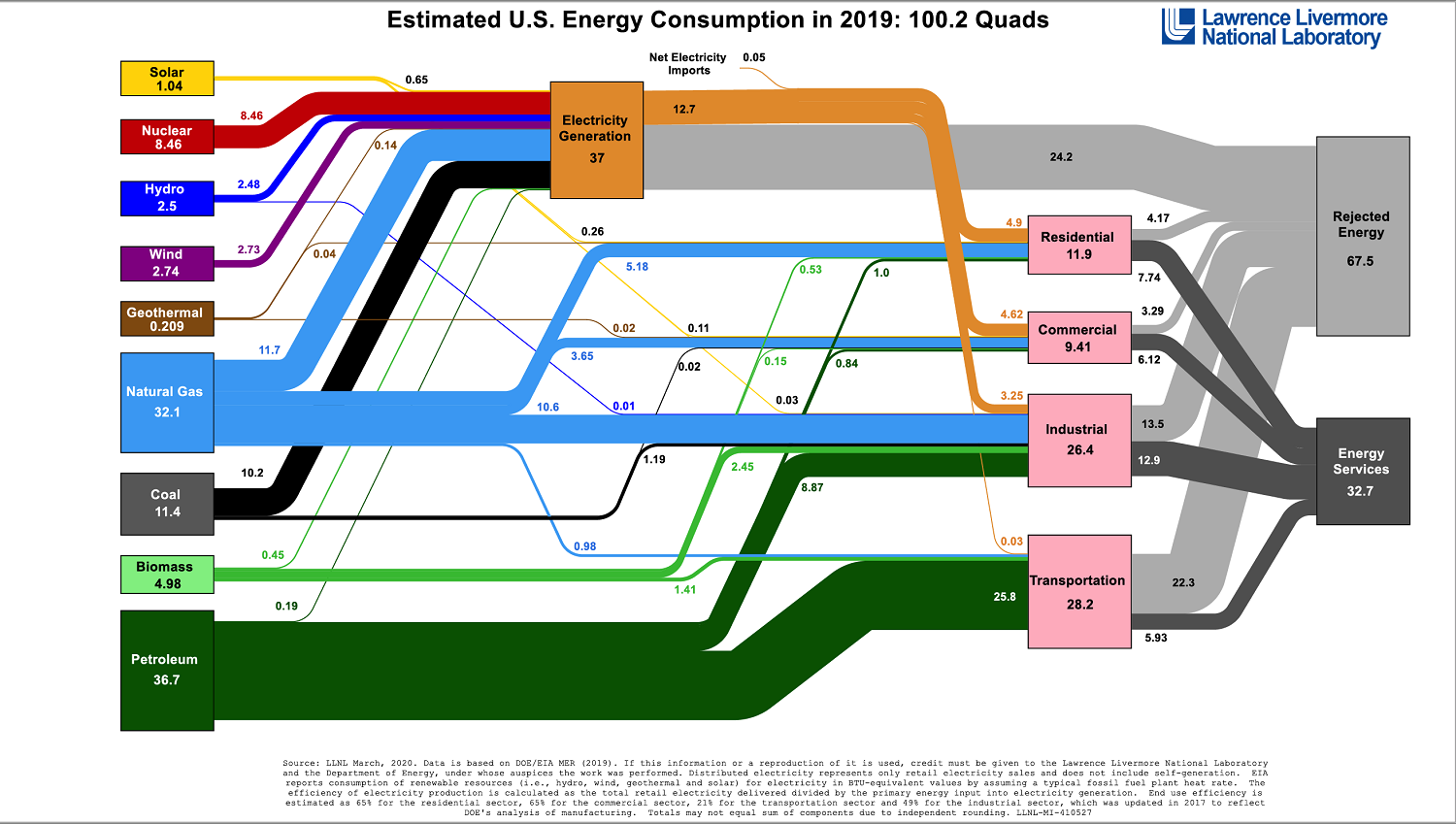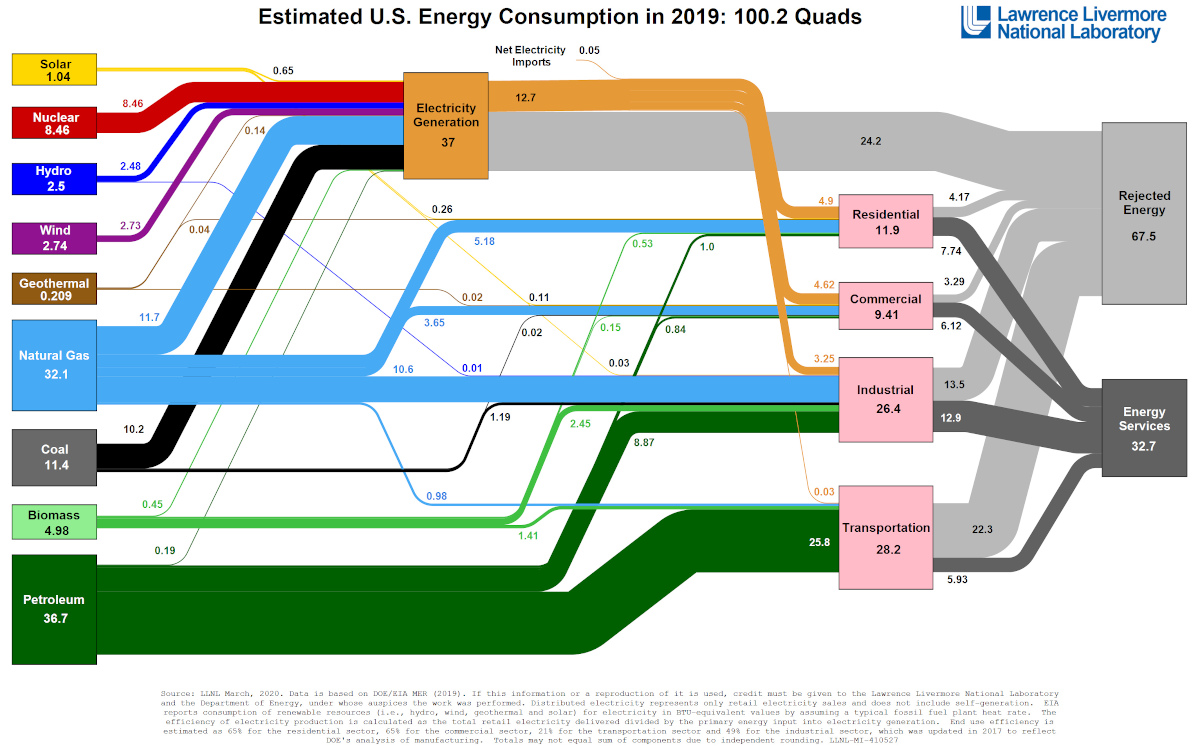Energy
Visualizing America’s Energy Use, in One Giant Chart

Visualizing America’s Energy Use, in One Giant Chart
Have you ever wondered where the country’s energy comes from, and how exactly it gets used?
Luckily, the Lawrence Livermore National Laboratory (LLNL) crunches the numbers every year, outputting an incredible flow diagram that covers the broad spectrum of U.S. energy use.
The 2019 version of this comprehensive diagram gives us an in-depth picture of the U.S. energy ecosystem, showing not only where energy originates by fuel source (i.e. wind, oil, natural gas, etc.) but also how it’s ultimately consumed by sector.
In Perspective: 2019 Energy Use
Below, we’ll use the unit of quads, with each quad worth 1 quadrillion BTUs, to compare data for the last five years of energy use in the United States. Each quad has roughly the same amount of energy as contained in 185 million barrels of crude oil.
| Year | Energy Consumption | Change (yoy) | Fossil Fuels in Mix |
|---|---|---|---|
| 2019 | 100.2 quads | -1.0 | 80.0% |
| 2018 | 101.2 quads | +3.5 | 80.2% |
| 2017 | 97.7 quads | +0.4 | 80.0% |
| 2016 | 97.3 quads | +0.1 | 80.8% |
| 2015 | 97.2 quads | -1.1 | 81.6% |
Interestingly, overall energy use in the U.S. actually decreased to 100.2 quads in 2019, similar to a decrease last seen in 2015.
It’s also worth noting that the percentage of fossil fuels used in the 2019 energy mix decreased by 0.2% from last year to make up 80.0% of the total. This effectively negates the small rise of fossil fuel usage that occurred in 2018.
Energy Use by Source
Which sources of energy are seeing more use, as a percentage of the total energy mix?
| 2015 | 2016 | 2017 | 2018 | 2019 | Change ('15-'19) | |
|---|---|---|---|---|---|---|
| Oil | 36.3% | 36.9% | 37.1% | 36.5% | 36.6% | +0.3% |
| Natural Gas | 29.0% | 29.3% | 28.7% | 30.6% | 32.0% | +3.0% |
| Coal | 16.1% | 14.6% | 14.3% | 13.1% | 11.4% | -4.7% |
| Nuclear | 8.6% | 8.7% | 8.6% | 8.3% | 8.4% | -0.2% |
| Biomass | 4.8% | 4.9% | 5.0% | 5.1% | 5.0% | +0.2% |
| Wind | 1.9% | 2.2% | 2.4% | 2.5% | 2.7% | +0.8% |
| Hydro | 2.5% | 2.5% | 2.8% | 2.7% | 2.5% | +0.0% |
| Solar | 0.5% | 0.6% | 0.8% | 0.9% | 1.0% | +0.5% |
| Geothermal | 0.2% | 0.2% | 0.2% | 0.2% | 0.2% | +0.0% |
Since 2015, natural gas has grown from 29% to 32% of the U.S. energy mix — while coal’s role in the mix has dropped by 4.7%.
In these terms, it can be hard to see growth in renewables, but looking at the data in more absolute terms can tell a different story. For example, in 2015 solar added 0.532 quads of energy to the mix, while in 2019 it accounted for 1.04 quads — a 95% increase.
Energy Consumption
Finally, let’s take a look at where energy goes by end consumption, and whether or not this is evolving over time.
| 2015 | 2016 | 2017 | 2018 | 2019 | Change ('15-'19) | |
|---|---|---|---|---|---|---|
| Residential | 15.6% | 15.2% | 14.7% | 15.7% | 15.7% | +0.1% |
| Commercial | 12.1% | 12.5% | 12.3% | 12.4% | 12.4% | +0.3% |
| Industrial | 33.9% | 33.8% | 34.5% | 34.6% | 34.8% | +0.9% |
| Transportation | 38.4% | 38.5% | 38.5% | 37.3% | 37.1% | -1.3% |
Residential, commercial, and industrial sectors are all increasing their use of energy, while the transportation sector is seeing a drop in energy use — likely thanks to more fuel efficient cars, EVs, public transport, and other factors.
The COVID-19 Effect on Energy Use
The energy mix is incredibly difficult to change overnight, so over the years these flow diagrams created by the Lawrence Livermore National Laboratory (LLNL) have not changed much.
One exception to this will be in 2020, which has seen an unprecedented shutdown of the global economy. As a result, imagining the next iteration of this energy flow diagram is basically anybody’s guess.
We can likely all agree that it’ll include increased levels of energy consumption in households and shortfalls everywhere else, especially in the transportation sector. However, the total amount of energy used — and where it comes from — might be a significant deviation from past years.
Energy
Charted: 4 Reasons Why Lithium Could Be the Next Gold Rush
Visual Capitalist has partnered with EnergyX to show why drops in prices and growing demand may make now the right time to invest in lithium.

4 Reasons Why You Should Invest in Lithium
Lithium’s importance in powering EVs makes it a linchpin of the clean energy transition and one of the world’s most precious minerals.
In this graphic, Visual Capitalist partnered with EnergyX to explore why now may be the time to invest in lithium.
1. Lithium Prices Have Dropped
One of the most critical aspects of evaluating an investment is ensuring that the asset’s value is higher than its price would indicate. Lithium is integral to powering EVs, and, prices have fallen fast over the last year:
| Date | LiOH·H₂O* | Li₂CO₃** |
|---|---|---|
| Feb 2023 | $76 | $71 |
| March 2023 | $71 | $61 |
| Apr 2023 | $43 | $33 |
| May 2023 | $43 | $33 |
| June 2023 | $47 | $45 |
| July 2023 | $44 | $40 |
| Aug 2023 | $35 | $35 |
| Sept 2023 | $28 | $27 |
| Oct 2023 | $24 | $23 |
| Nov 2023 | $21 | $21 |
| Dec 2023 | $17 | $16 |
| Jan 2024 | $14 | $15 |
| Feb 2024 | $13 | $14 |
Note: Monthly spot prices were taken as close to the 14th of each month as possible.
*Lithium hydroxide monohydrate MB-LI-0033
**Lithium carbonate MB-LI-0029
2. Lithium-Ion Battery Prices Are Also Falling
The drop in lithium prices is just one reason to invest in the metal. Increasing economies of scale, coupled with low commodity prices, have caused the cost of lithium-ion batteries to drop significantly as well.
In fact, BNEF reports that between 2013 and 2023, the price of a Li-ion battery dropped by 82%.
| Year | Price per KWh |
|---|---|
| 2023 | $139 |
| 2022 | $161 |
| 2021 | $150 |
| 2020 | $160 |
| 2019 | $183 |
| 2018 | $211 |
| 2017 | $258 |
| 2016 | $345 |
| 2015 | $448 |
| 2014 | $692 |
| 2013 | $780 |

3. EV Adoption is Sustainable
One of the best reasons to invest in lithium is that EVs, one of the main drivers behind the demand for lithium, have reached a price point similar to that of traditional vehicle.
According to the Kelly Blue Book, Tesla’s average transaction price dropped by 25% between 2022 and 2023, bringing it in line with many other major manufacturers and showing that EVs are a realistic transport option from a consumer price perspective.
| Manufacturer | September 2022 | September 2023 |
|---|---|---|
| BMW | $69,000 | $72,000 |
| Ford | $54,000 | $56,000 |
| Volkswagon | $54,000 | $56,000 |
| General Motors | $52,000 | $53,000 |
| Tesla | $68,000 | $51,000 |
4. Electricity Demand in Transport is Growing
As EVs become an accessible transport option, there’s an investment opportunity in lithium. But possibly the best reason to invest in lithium is that the IEA reports global demand for the electricity in transport could grow dramatically by 2030:
| Transport Type | 2022 | 2025 | 2030 |
|---|---|---|---|
| Buses 🚌 | 23,000 GWh | 50,000 GWh | 130,000 GWh |
| Cars 🚙 | 65,000 GWh | 200,000 GWh | 570,000 GWh |
| Trucks 🛻 | 4,000 GWh | 15,000 GWh | 94,000 GWh |
| Vans 🚐 | 6,000 GWh | 16,000 GWh | 72,000 GWh |
The Lithium Investment Opportunity
Lithium presents a potentially classic investment opportunity. Lithium and battery prices have dropped significantly, and recently, EVs have reached a price point similar to other vehicles. By 2030, the demand for clean energy, especially in transport, will grow dramatically.
With prices dropping and demand skyrocketing, now is the time to invest in lithium.
EnergyX is poised to exploit lithium demand with cutting-edge lithium extraction technology capable of extracting 300% more lithium than current processes.

-

 Lithium4 days ago
Lithium4 days agoRanked: The Top 10 EV Battery Manufacturers in 2023
Asia dominates this ranking of the world’s largest EV battery manufacturers in 2023.
-

 Energy1 week ago
Energy1 week agoThe World’s Biggest Nuclear Energy Producers
China has grown its nuclear capacity over the last decade, now ranking second on the list of top nuclear energy producers.
-

 Energy1 month ago
Energy1 month agoThe World’s Biggest Oil Producers in 2023
Just three countries accounted for 40% of global oil production last year.
-

 Energy1 month ago
Energy1 month agoHow Much Does the U.S. Depend on Russian Uranium?
Currently, Russia is the largest foreign supplier of nuclear power fuel to the U.S.
-

 Uranium2 months ago
Uranium2 months agoCharted: Global Uranium Reserves, by Country
We visualize the distribution of the world’s uranium reserves by country, with 3 countries accounting for more than half of total reserves.
-

 Energy3 months ago
Energy3 months agoVisualizing the Rise of the U.S. as Top Crude Oil Producer
Over the last decade, the United States has established itself as the world’s top producer of crude oil, surpassing Saudi Arabia and Russia.
-

 Debt1 week ago
Debt1 week agoHow Debt-to-GDP Ratios Have Changed Since 2000
-

 Markets2 weeks ago
Markets2 weeks agoRanked: The World’s Top Flight Routes, by Revenue
-

 Demographics2 weeks ago
Demographics2 weeks agoPopulation Projections: The World’s 6 Largest Countries in 2075
-

 Markets2 weeks ago
Markets2 weeks agoThe Top 10 States by Real GDP Growth in 2023
-

 Demographics2 weeks ago
Demographics2 weeks agoThe Smallest Gender Wage Gaps in OECD Countries
-

 Economy2 weeks ago
Economy2 weeks agoWhere U.S. Inflation Hit the Hardest in March 2024
-

 Green2 weeks ago
Green2 weeks agoTop Countries By Forest Growth Since 2001
-

 United States2 weeks ago
United States2 weeks agoRanked: The Largest U.S. Corporations by Number of Employees










